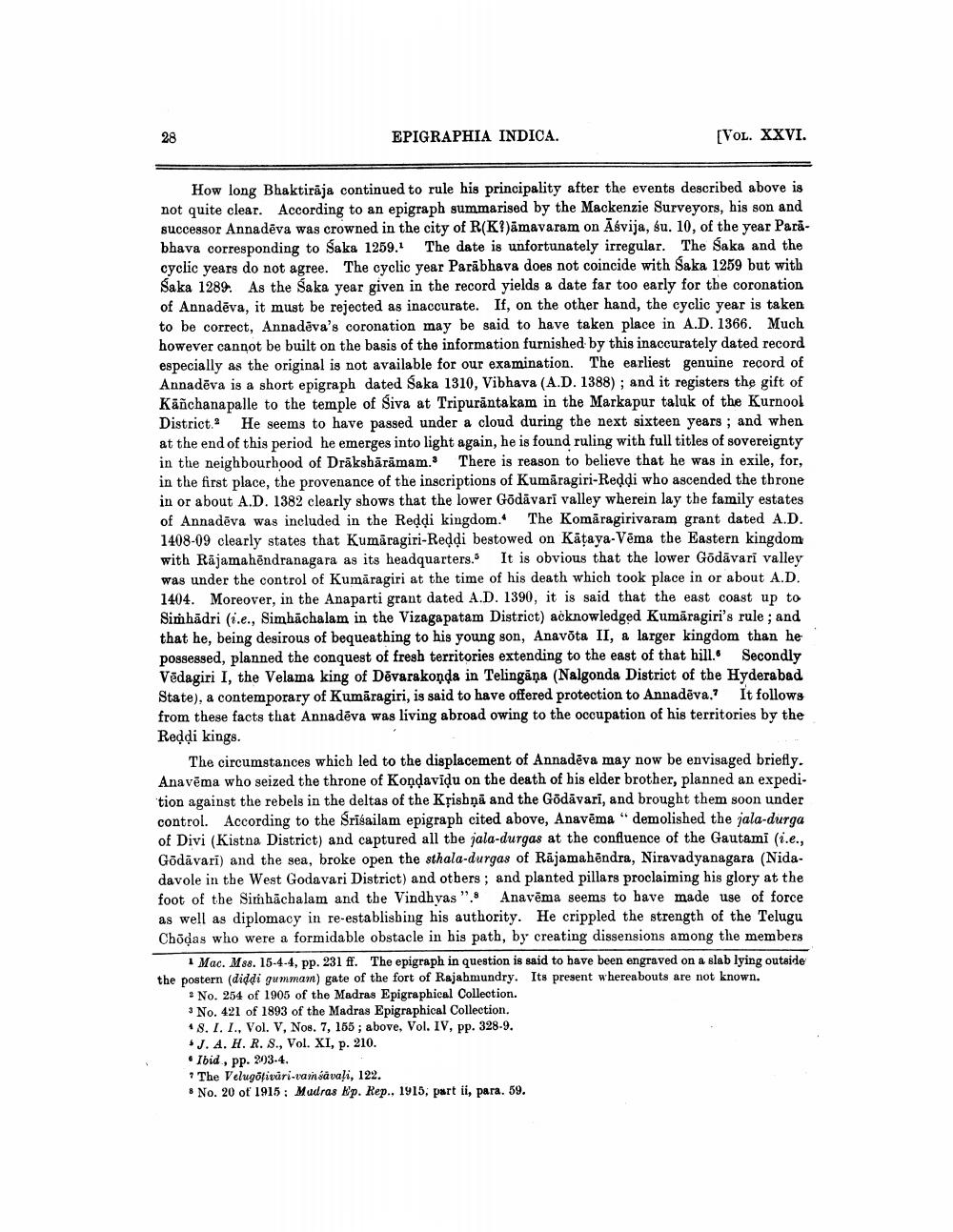________________
EPIGRAPHIA INDICA.
[Vol. XXVI.
How long Bhaktirāja continued to rule his principality after the events described above is not quite clear. According to an epigraph summarised by the Mackenzie Surveyors, his son and successor Annadēva was crowned in the city of R(K?)āmavaram on Aśvija, śu. 10, of the year Parabhava corresponding to Saka 1259. The date is unfortunately irregular. The Saka and the cyclic years do not agree. The cyclic year Parābhava does not coincide with Saka 1259 but with Saka 1289. As the Saka year given in the record yields a date far too early for the coronation of Annadēva, it must be rejected as inaccurate. If, on the other hand, the cyclic year is taken to be correct, Annadēva's coronation may be said to have taken place in A.D. 1366. Much however cannot be built on the basis of the information furnished by this inaccurately dated record especially as the original is not available for our examination. The earliest genuine record of Annadēva is a short epigraph dated Saka 1310, Vibhava (A.D. 1388); and it registers the gift of Kanchanapalle to the temple of Siva at Tripurantakam in the Markapur taluk of the Kurnool District. He seems to have passed under a cloud during the next sixteen years; and when at the end of this period he emerges into light again, he is found ruling with full titles of sovereignty in the neighbourhood of Drāksbārāmam. There is reason to believe that he was in exile, for, in the first place, the provenance of the inscriptions of Kumāragiri-Reddi who ascended the throne in or about A.D. 1382 clearly shows that the lower Godavari valley wherein lay the family estates of Annadēva was included in the Reddi kingdom. The Komāragirivaram grant dated A.D. 1408-09 clearly states that Kumāragiri-Reddi bestowed on Kätaya Vēma the Eastern kingdom with Rājamahendranagara as its headquarters. It is obvious that the lower Gödāvari valley was under the control of Kumāragiri at the time of his death which took place in or about A.D. 1404. Moreover, in the Anaparti grant dated A.D. 1390, it is said that the east coast up to Simhädri (i.e., Simhachalam in the Vizaga patam District) acknowledged Kumäragiri's rule ; and that he, being desirous of bequeathing to his young son, Anavöta II, a larger kingdom than he possessed, planned the conquest of fresh territories extending to the east of that hill. Secondly Vēdagiri I, the Velama king of Dēvarakonda in Telingana (Nalgonda District of the Hyderabad State), a contemporary of Kumāragiri, is said to have offered protection to Annadēva.? It follows from these facts that Annadēva was living abroad owing to the occupation of his territories by the Reddi kings.
The circumstances which led to the displacement of Annadēva may now be envisaged briefly. Anavēma who seized the throne of Kondavidu on the death of his elder brother, planned an expedi. tion against the rebels in the deltas of the Kộishņā and the Gödāvari, and brought them soon under control. According to the Srisailam epigraph cited above, Anavēma " demolished the jala-durga of Divi (Kistna District) and captured all the jala-durgas at the confluence of the Gautami (i.e., Gödāvari) and the sea, broke open the sthala-durgas of Rājamahēndra, Niravadyanagara (Nidadavole in the West Godavari District) and others; and planted pillars proclaiming his glory at the foot of the Simhachalam and the Vindhyas". Anavēma seems to bave made use of force as well as diplomacy in re-establishing his authority. He crippled the strength of the Telugu Chōdas who were a formidable obstacle in his path, by creating dissensions among the members
Mac. M88. 15-4-4, pp. 231 ff. The epigraph in question is said to have been engraved on a slab lying outside the postern (diddi gumman) gate of the fort of Rajahmundry. Its present whereabouts are not known.
: No. 254 of 1905 of the Madras Epigraphical Collection. * No. 421 of 1893 of the Madras Epigraphical Collection. 18. I. I., Vol. V, Nos. 7, 155 ; above, Vol. IV, pp. 328-9.
J. A. H. R. S., Vol. XI, p. 210. • Ibid, pp. 203-4. * The Velugöfivuri-vamšāvaļi, 122. * No. 20 of 1915 : Mudras Kp. Rep., 1915, part ii, para. 59.




